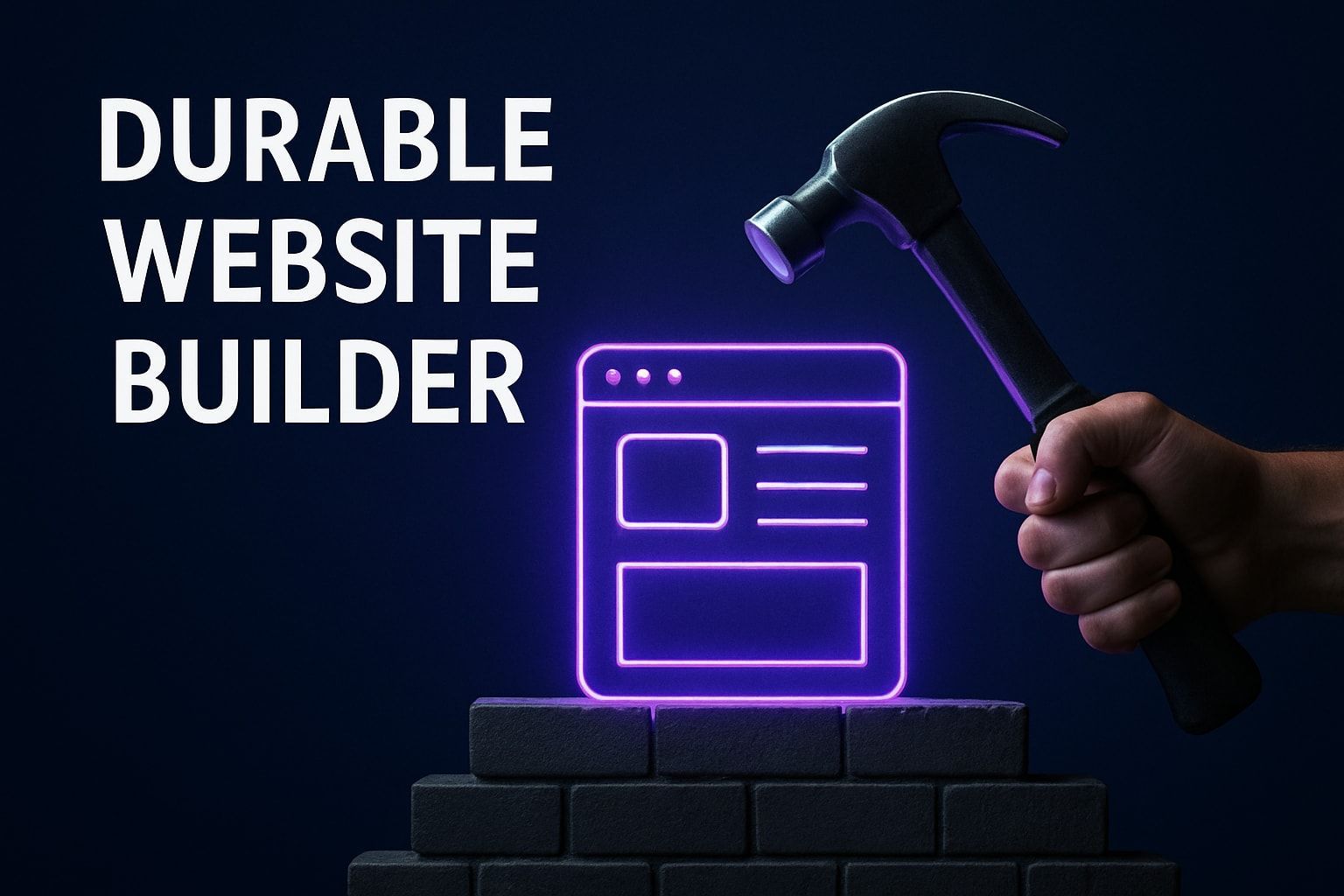7 Best Build Templates to Streamline Your Projects in 2025
Projects are moving faster than ever in 2025, and the demands on teams are only increasing. Managing tight deadlines, complex requirements, and cross-functional collaboration can quickly become overwhelming.
That’s where build templates come into play. The right template can transform chaos into clarity, helping you streamline your workflow, reduce costly errors, and achieve results in record time.
In this post, we’ll reveal the 7 best build templates to help you tackle every major project management or development challenge. Ready to work smarter, not harder? Dive in and discover your next productivity boost.
Why Build Templates Are Essential for Project Success
As project teams face growing demands and tighter deadlines, template-driven workflows have become a game changer. The adoption of build templates is transforming how projects are planned, executed, and delivered. Instead of reinventing the wheel for every new initiative, teams can leverage pre-built frameworks that automate repetitive tasks and standardize processes. This shift toward automation and repeatability is evident across industries, with both technical and non-technical teams seeking ways to work smarter, not harder. If you’re looking to see the full spectrum of what’s possible, you can explore all website templates and discover how diverse solutions fit every workflow.
The Rise of Template-Driven Workflows
Build templates have become essential tools for saving time and minimizing errors. By automating routine steps and providing a reliable starting point, they allow teams to launch projects faster and with greater confidence. The growing popularity of build templates is fueled by their ability to ensure repeatable success, whether you’re rolling out a marketing campaign or deploying code.
Teams across all functions are embracing these tools, recognizing that build templates are not just for developers. Marketers, designers, and operations teams now rely on standardized templates to keep projects on track and avoid missteps. The rise in template-driven approaches is helping organizations achieve more with less effort and fewer mistakes.
Key Benefits of Using Build Templates
The advantages of build templates go well beyond convenience. Here’s what makes them indispensable for modern project delivery:
- Consistency: Every project follows the same proven structure, reducing confusion.
- Faster Onboarding: New team members can ramp up quickly using familiar templates.
- Error Reduction: Checklists and predefined steps help prevent costly mistakes.
- Speed: Projects kick off and reach completion more quickly.
Using build templates also means teams spend less time on setup and more on actual execution. This leads to smoother collaboration and higher-quality outcomes, with fewer bottlenecks along the way.
Common Use Cases Across Industries
Build templates are used across a wide range of industries, each with unique needs:
- Software Development: CI/CD pipeline templates, deployment scripts, code review checklists.
- Marketing: Campaign launch templates, asset production checklists.
- Construction: Project timeline templates, resource allocation sheets.
- Design: Branding kits, presentation frameworks.
No matter the field, build templates empower teams to standardize best practices, improve transparency, and accelerate delivery. The flexibility of these templates means they can be tailored to suit the specifics of any project, from launching a website to managing a construction timeline.
Data & Trends
Recent industry surveys highlight the measurable impact of build templates:
| Metric | Impact |
|---|---|
| Faster Project Completion | 60% of organizations report improvement |
| Reduced Project Start-Up Time | 30% average reduction |
| Increased Collaboration & Transparency | Significant gains in template-driven teams |
These trends point to a future where build templates are central to every successful project. Teams that standardize their workflows with templates consistently see reduced delays, fewer errors, and better overall outcomes.
7 Best Build Templates to Streamline Your Projects in 2025
Choosing the right build templates can make or break your project’s success in 2025. With countless options out there, it’s essential to focus on templates that combine speed, flexibility, and collaboration. Below, you’ll find the seven best build templates—each tailored to a different workflow—so you can streamline your processes, reduce errors, and deliver results faster than ever.
Avantiy Website Build Template
The Avantiy Website Build Template is a game-changer for anyone who wants to launch a professional website with minimal hassle. Designed for both coders and non-coders, this platform offers a rich suite of build templates that adapt to your needs.
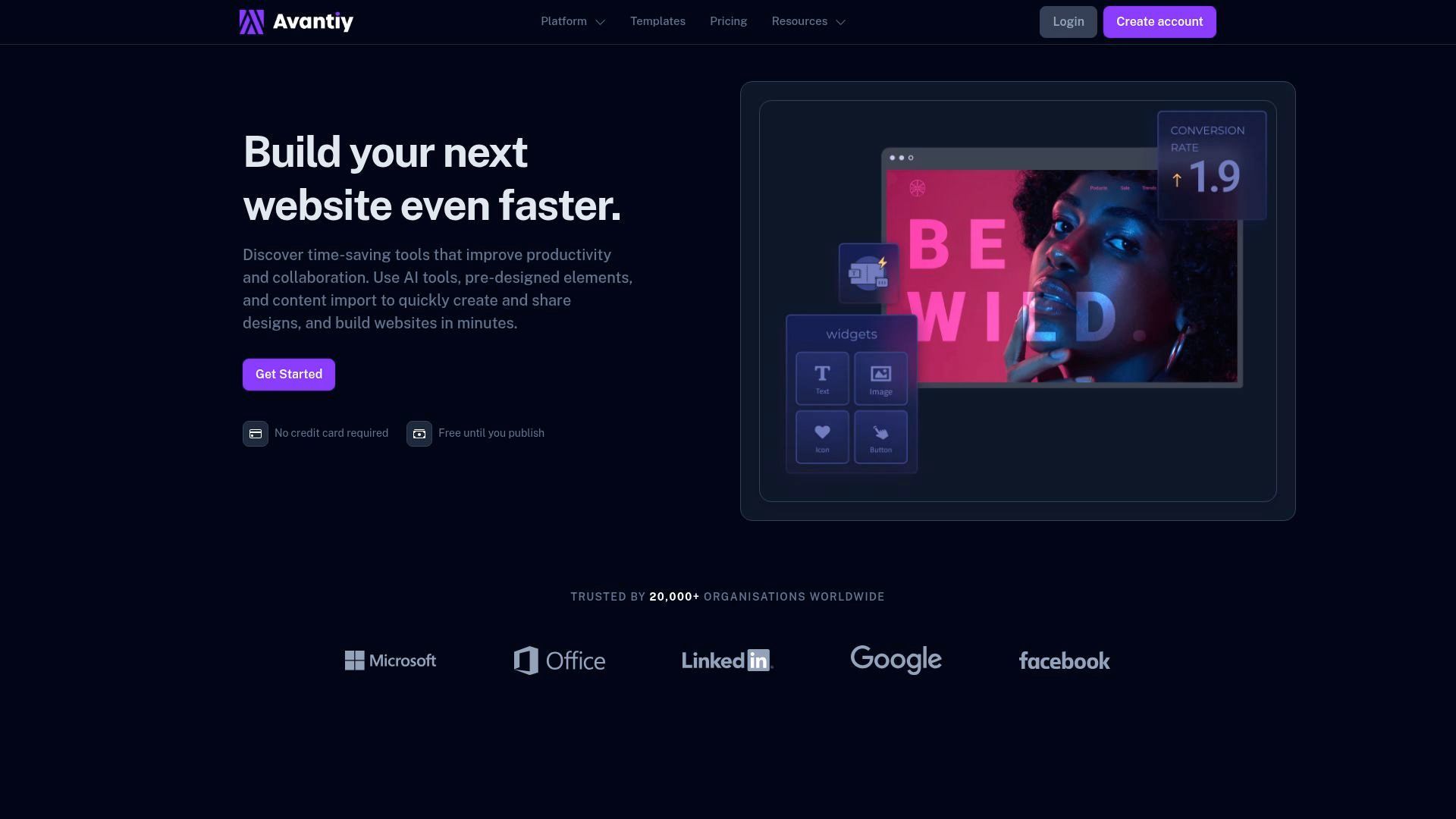
Pricing: Free until you publish. For more details, visit their pricing page.
Core Features:
- AI-powered drag-and-drop editor
- Customizable templates and dynamic content collections
- Built-in SEO tools
- 400+ integrations for seamless workflow
Key Benefits:
- Launch mobile-friendly, professional websites in hours
- AI-generated content and design suggestions
- Real-time team collaboration
Unique Selling Points:
- Industry-leading Core Web Vitals scores
- Unlimited storage and robust security
- Scalable for agencies, SMBs, and individuals
Who Should Use It?
- Individuals, startups, small businesses, agencies, and those without coding experience
I
deal Use Cases:
- Rapid website launches
- eCommerce stores and portfolios
- Content-driven or marketing sites
P
ros:
- Fast setup with AI productivity tools
- No coding required
- Free to start
Cons:
- Some advanced features require a paid plan
If you want to supercharge your workflow, Avantiy’s AI assistant for templates can help you create and customize build templates even faster.
Canva Building Presentation Template
When it comes to creating visually compelling presentations, Canva’s Building Presentation Template stands out. This build template is perfect for teams who need to communicate project progress, proposals, or updates in a polished format.
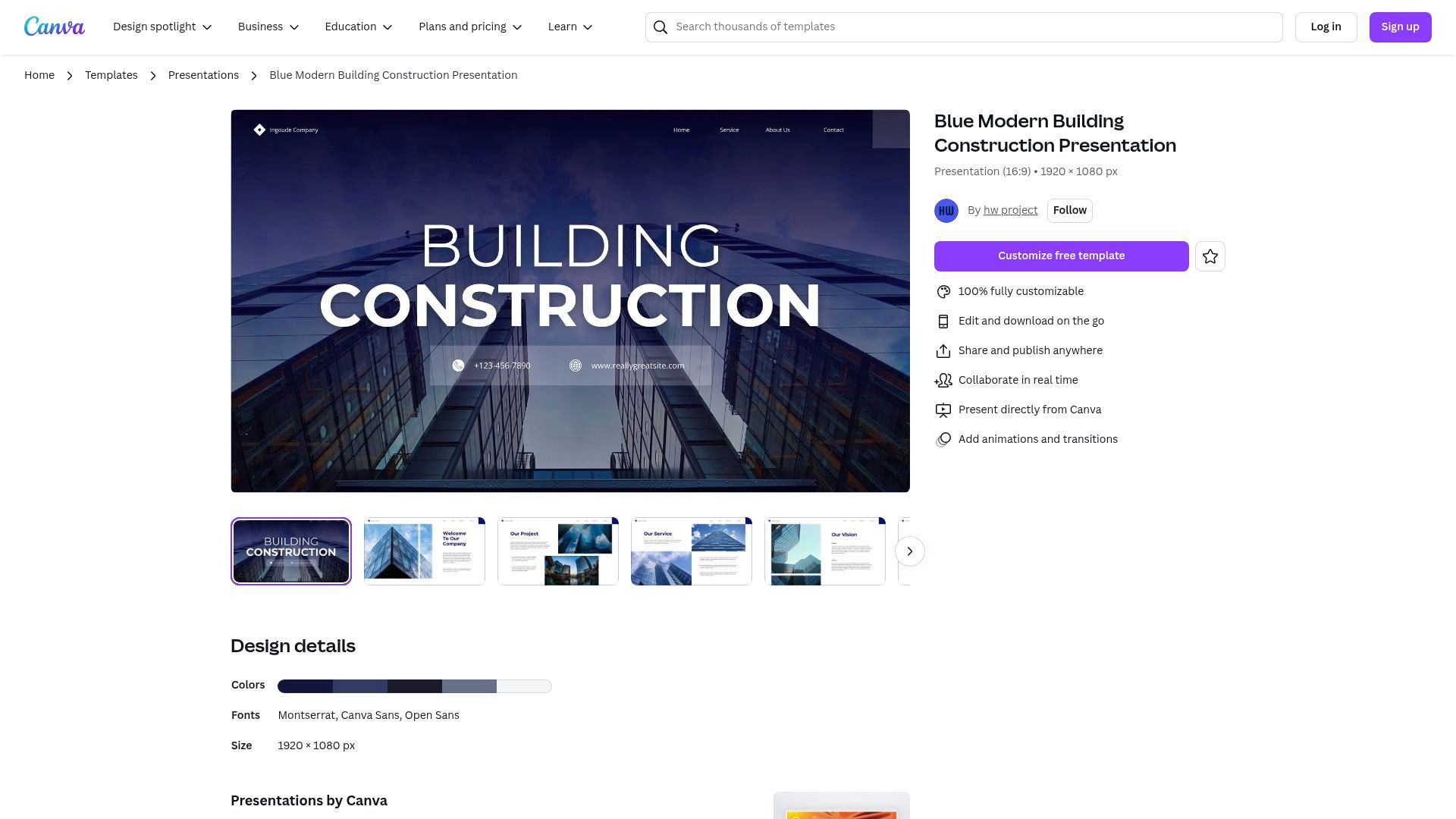
Pricing: Free and Pro options available.
Core Features:
- Fully customizable design elements
- Drag-and-drop interface
- Real-time collaboration for teams
Key Benefits:
- Quickly create professional presentations
- Maintain brand consistency across projects
- Effortless sharing with stakeholders
Unique Selling Points:
- Huge template library for various industries
- Intuitive, cloud-based platform
Target Audience:
- Project managers, architects, construction teams, and design agencies
Ideal Use Cases:
- Project proposals and status updates
- Client presentations
Pros:
- User-friendly and collaborative
- Visually appealing results
Cons:
- Advanced features require Pro subscription
This build template empowers teams to focus on content, not formatting, for every project milestone.
Trello Project Management Board Template
Trello’s Project Management Board Template is a favorite among agile teams and remote workers. Its visual Kanban approach makes managing build templates and tasks intuitive and flexible.
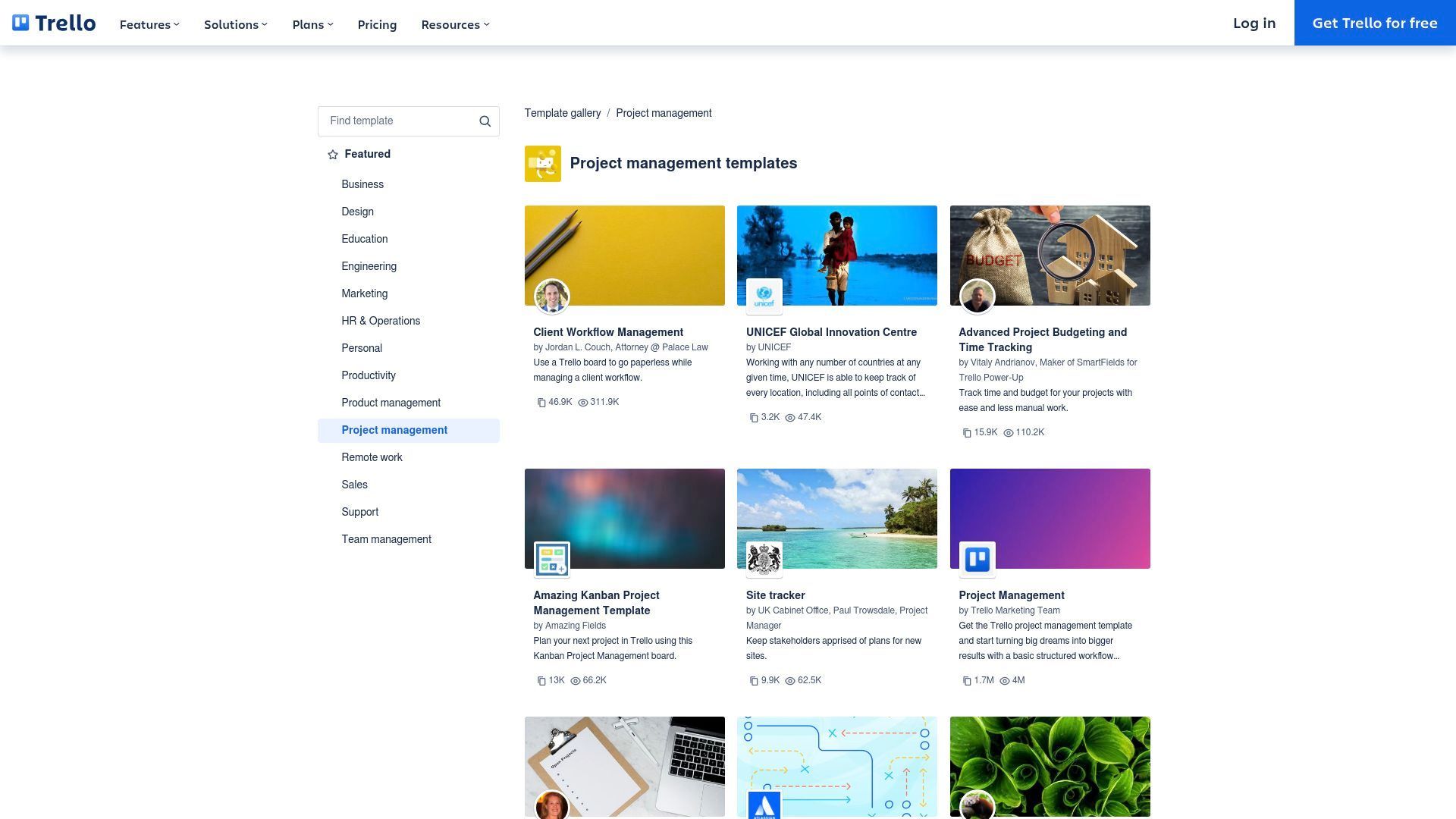
Pricing: Free plan available; paid plans start at $5/user/month.
Core Features:
- Kanban boards with customizable lists and cards
- Automation with Butler
- Integrations with Slack, Google Drive, and more
Key Benefits:
- Visual task tracking for any workflow
- Simplifies collaboration in distributed teams
- Automates repetitive actions
Unique Selling Points:
- Highly adaptable to any project type
- Robust plugin and integration ecosystem
Target Audience:
- Teams of all sizes, especially remote or hybrid teams
Ideal Use Cases:
- Software development, marketing campaigns, and event planning
Pros:
- Flexible and easy to use
- Integrates with many popular tools
Cons:
- Can become cluttered with large projects
- Limited reporting on the free plan
Whether you’re managing a sprint or launching a campaign, this build template keeps everyone aligned.
ClickUp Project Timeline Template
ClickUp’s Project Timeline Template is built for teams who need to visualize complex schedules and dependencies. This build template brings clarity to project timelines and resource allocation.
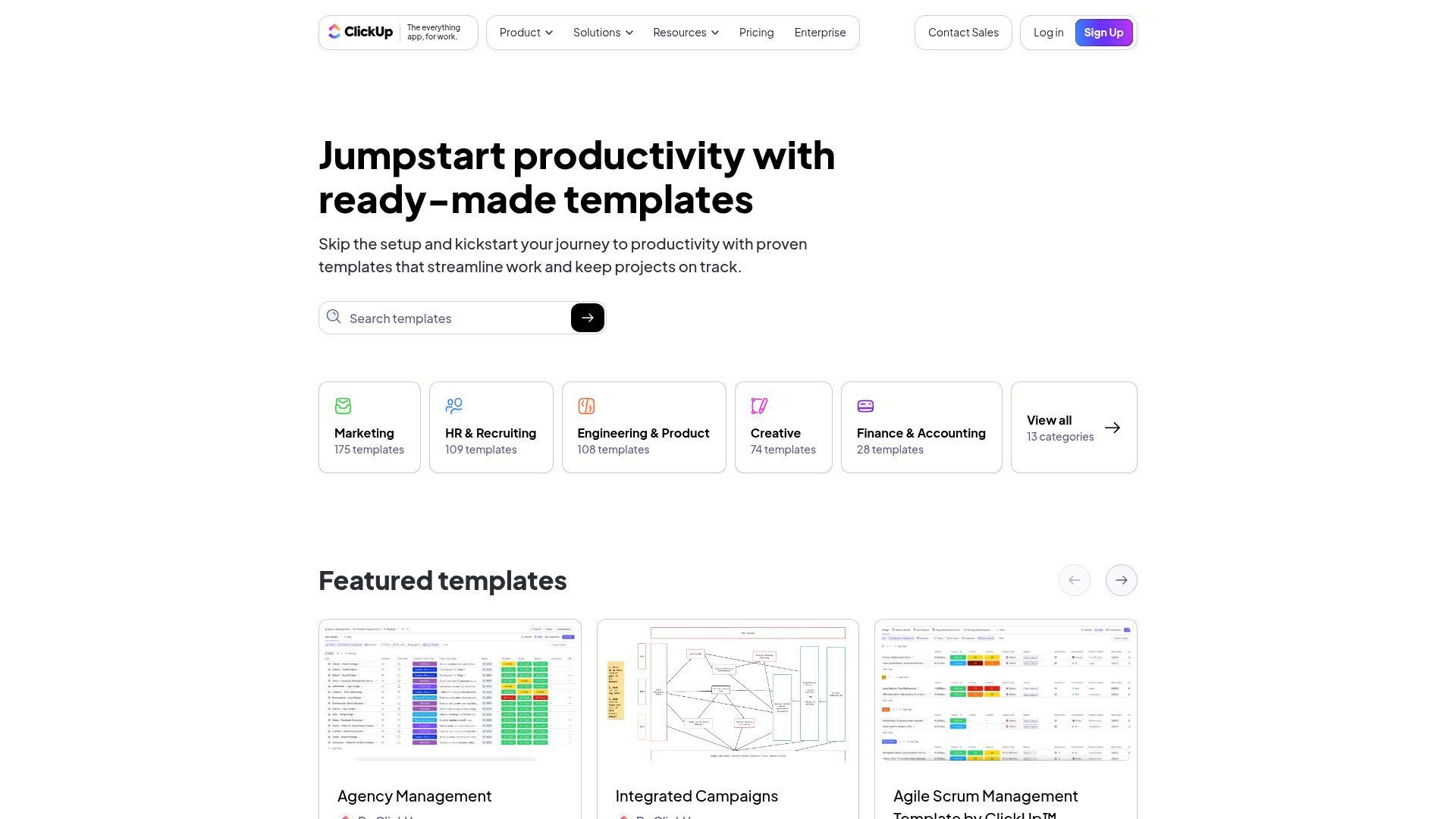
Pricing: Free plan; paid plans from $7/member/month.
Core Features:
- Gantt charts and task dependencies
- Built-in time tracking
- Collaboration tools for real-time updates
Key Benefits:
- Centralizes project schedules and milestones
- Visualizes dependencies for better planning
- Improves deadline management
Unique Selling Points:
- All-in-one workspace for tasks, docs, and communication
- Customizable views for every workflow
- Automation to minimize manual work
Target Audience:
- Project managers, cross-functional teams, and startups
Ideal Use Cases:
- Product launches and software sprints
- Construction schedules
Pros:
- Comprehensive features for complex projects
- Highly customizable
Cons:
- Steeper learning curve for new users
- Some features gated to paid plans
This build template is your go-to for turning chaotic schedules into organized, actionable plans.
Jira Software Scrum Board Template
For agile software teams, Jira’s Scrum Board Template is the industry standard. This build template is designed to streamline sprint planning, backlog management, and team collaboration.
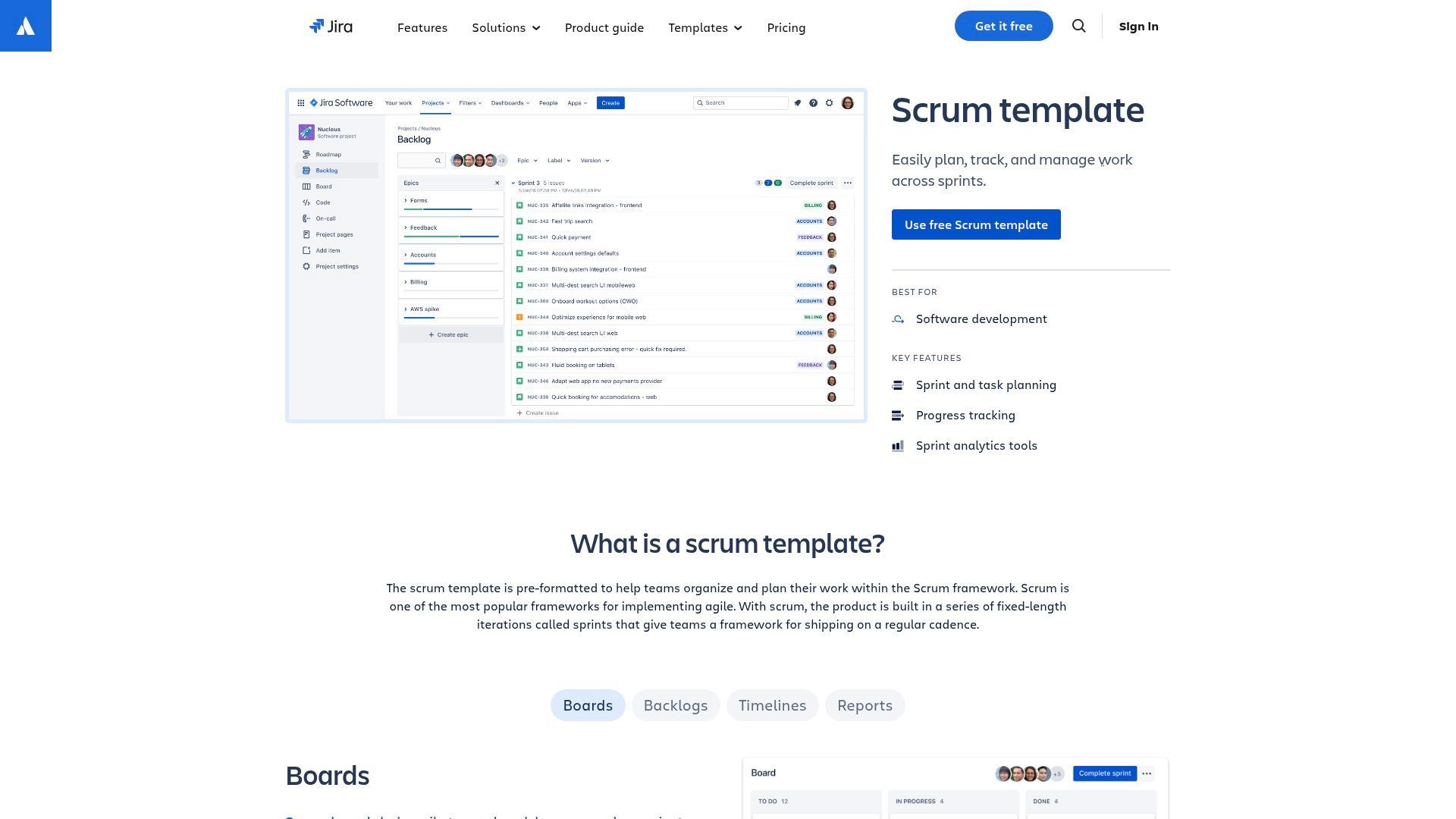
Pricing: Free for up to 10 users; Standard plan from $7.75/user/month.
Core Features:
- Scrum boards and backlog management
- Sprint planning and tracking
- Detailed reporting (burndown charts, velocity)
Key Benefits:
- Streamlines agile workflows and team transparency
- Tracks sprint progress and team performance
- Deep integration with developer tools
Unique Selling Points:
- Customizable workflows for any team
- Robust analytics and reporting tools
Target Audience:
- Software development teams, agile practitioners, and tech startups
I
deal Use Cases:
- Sprint planning, bug tracking, feature releases
Pros:
- Scalable and flexible for growing teams
- Powerful reporting and analytics
Cons:
- Can be complex for smaller teams
- Setup and customization require time
This build template helps teams adapt quickly, ensuring every sprint is data-driven and transparent.
Notion Project Documentation Template
Notion’s Project Documentation Template centralizes all your project knowledge in one place. As a build template, it’s ideal for teams who value organization and seamless knowledge sharing.
Pricing: Free for personal use; team plans from $8/user/month.
Core Features:
- Linked databases and collaborative editing
- Rich media embedding and version history
Key Benefits:
- Keeps project info consistent and accessible
- Supports onboarding and process documentation
- Fosters team knowledge sharing
Unique Selling Points:
- Highly customizable for any workflow
- Integrates with other productivity tools
Target Audience:
- Agencies, remote teams, startups, and freelancers
I
deal Use Cases:
- Project wikis, onboarding guides, and process docs
Pros:
- Flexible and easy to update
- Great for knowledge management
Cons:
- Can get disorganized without structure
- Some features require a paid plan
If you want your team to stay aligned, this build template is a must-have for documentation.
Miro Project Planning Whiteboard Template
Miro’s Project Planning Whiteboard Template is made for brainstorming, mapping workflows, and driving collaboration. It’s one of the most interactive build templates for creative teams.

Pricing: Free plan; paid plans from $8/user/month.
Core Features:
- Infinite canvas and sticky notes
- Flowcharts and real-time collaboration
- Integrations with Zoom, Slack, and more
Key Benefits:
- Facilitates brainstorming and project mapping
- Supports cross-team ideation and planning
- Interactive tools for hybrid and remote teams
Unique Selling Points:
- Extensive template gallery for all needs
- Supports large, distributed teams
Target Audience:
- Product managers, designers, agile teams, educators
Ideal Use Cases:
- Project kick-offs, workflow mapping, retrospectives
Pros:
- Highly collaborative and visual
- Scales for large teams
Cons:
- Can be overwhelming for simple projects
- Advanced features behind paywall
For teams looking to unlock creativity, this build template offers limitless possibilities.
With these seven build templates, you’re equipped to handle any project—no matter the size or complexity. The right choice will help you streamline workflows, boost collaboration, and drive results in 2025.
How to Choose the Right Build Template for Your Project
Selecting the optimal build templates for your projects can make the difference between seamless execution and frustrating delays. With so many options available, it’s essential to approach your choice methodically. By evaluating your project’s requirements and your team’s workflow, you’ll ensure that your build templates truly empower your results.
Assessing Project Scope and Complexity
Begin by matching build templates to your project’s size and specific demands. Are you managing a small marketing campaign or orchestrating a multi-phase software launch? The template you select should align with your team structure and the number of moving parts.
For complex projects, look for build templates that support dependencies, multiple phases, and integrations with tools your team already uses. Simpler projects may benefit from lightweight, easy-to-adopt templates. Evaluating scope early ensures your build templates don’t become a bottleneck later on.
Customization and Scalability
No two projects are identical, so your build templates should offer customization options. A template that’s too rigid can stifle creativity or miss key requirements. Choose build templates that let you tailor workflows, fields, and layouts to fit your unique needs.
As your team or project grows, scalability becomes crucial. Templates should adapt to increased complexity or new team members. Scalable build templates help you future-proof your workflow, so you’re not forced to switch tools mid-project.
Collaboration and Accessibility
Today’s teams are often distributed or hybrid, making collaboration a top priority. Build templates that enable real-time editing, commenting, and sharing keep everyone aligned. Cloud-based solutions are especially valuable, as they allow access from anywhere and streamline updates.
Look for build templates designed with teamwork in mind. Features like permissions, activity logs, and integrations with communication tools boost transparency. Prioritizing collaboration ensures everyone stays on the same page, regardless of location.
Cost Considerations
Budget plays a significant role when choosing build templates. Many platforms offer both free and paid versions, each with different levels of functionality. Assess what’s included in each tier—some advanced features may only be available with a subscription.
Consider the return on investment: will premium build templates save time or reduce errors enough to justify the cost? For example, you can compare website build template pricing to see what features you get at each level. Making a cost-effective choice supports project efficiency without overspending.
Support and Community Resources
Finally, evaluate the support and resources available for your chosen build templates. Robust documentation, tutorials, and customer service speed up onboarding and troubleshooting. An active user community can provide tips, templates, and solutions to common challenges.
Access to a growing template library and regular updates ensures your build templates stay relevant as technology and best practices evolve. Prioritizing support helps your team make the most of your investment and adapt quickly to new needs.
Best Practices for Implementing Build Templates in 2025
Implementing build templates effectively in 2025 can transform the way your team works. A thoughtful rollout ensures everyone benefits from the efficiency and consistency these tools promise. Let’s explore the most effective strategies for driving adoption and getting the most from your build templates.
Onboarding and Training Your Team
Rolling out new build templates starts with clear onboarding. Provide step-by-step walkthroughs to guide your team through template features and best practices. Use short training videos, live demos, or interactive workshops to make learning engaging.
Create internal documentation tailored to your processes. Encourage team members to ask questions and share tips as they explore the templates. When everyone understands how to use build templates, adoption rates soar and productivity follows.
Maintaining Consistency and Quality
Consistency is the backbone of successful build templates. Set clear guidelines for how and when to use each template. Develop a simple checklist for template updates, ensuring that all team members are always working from the latest version.
Schedule regular reviews to keep templates relevant as your projects evolve. Assign a template owner or small group to manage updates and gather feedback. This approach helps maintain quality and minimizes confusion across teams using build templates.
Leveraging Automation and Integrations
A major advantage of modern build templates is automation. Look for templates that support integrations with your favorite project management, communication, and storage tools. Automation reduces manual work, freeing up your team to focus on higher-value tasks.
For example, integrating build templates with AI-powered tools can streamline workflows and minimize errors. Learn more about the latest AI integration in project management to stay ahead of the curve and unlock new efficiencies.
Measuring Impact and Iterating
Track key metrics to see how build templates are improving your workflow. Use data points like project completion times, error rates, and team satisfaction scores to measure impact.
Encourage team members to provide feedback on what’s working and what needs adjustment. Regularly refine your build templates based on these insights. This cycle of measurement and iteration ensures your templates continue to deliver real value.
Case Examples and Success Stories
Organizations across industries have seen dramatic improvements from standardized build templates. For instance, many report up to a 50% reduction in project delays after implementing consistent practices.
With the project management software market growth accelerating, more teams are embracing template-driven workflows for better results. Real-world case studies highlight how structured use of build templates leads to faster delivery and improved collaboration.
Future Trends in Build Templates and Project Automation
The world of build templates is evolving quickly, with 2025 shaping up to be a pivotal year. As organizations look for ways to boost efficiency, several breakthrough trends are set to redefine how teams approach project automation. From artificial intelligence to enhanced collaboration, let’s explore what the future holds for build templates.
AI and Machine Learning Integration
Artificial intelligence is rapidly becoming a core feature of modern build templates. In 2025, expect smarter templates that can recommend structures, auto-generate content, and even predict project risks before they arise. Machine learning algorithms will analyze previous project data, helping teams avoid common pitfalls and optimize workflows.
For a deeper dive into how AI is transforming project management, including predictive planning and risk management, check out AI's impact on project management. These advancements make build templates more intuitive and powerful, allowing teams to work smarter, not harder.
Increased Personalization and Industry-Specific Templates
One size rarely fits all in project management. The future will see a rise in highly personalized build templates, tailored for specific industries and business processes. Whether you’re in healthcare, construction, or marketing, you’ll find templates designed to address your unique challenges.
This shift means teams can skip generic solutions and instead leverage build templates that fit their workflow like a glove. Specialized libraries will continue to expand, offering templates for everything from agile software sprints to compliance checklists in regulated industries.
Enhanced Collaboration Features
Collaboration is at the heart of successful projects, and build templates are getting a major upgrade in this department. Real-time, multi-user editing is becoming standard, with advanced permissions and instant feedback tools built directly into templates.
Teams can leave comments, assign tasks, and track changes live, no matter where they are. These features reduce friction, improve transparency, and ensure everyone is aligned. As remote and hybrid work persists, expect collaboration within build templates to become even more seamless and interactive.
Cross-Platform and API-Driven Workflows
Integration is the name of the game for future build templates. APIs are making it easier to connect templates with tools like Slack, Jira, and Google Drive, enabling data to flow effortlessly across platforms. This cross-platform capability ensures that teams can work from web, mobile, or desktop without missing a beat.
With build templates adapting to any environment, project data remains consistent and accessible. Automation via APIs also helps streamline repetitive tasks, giving teams more time to focus on strategic work.
The Role of Templates in Remote and Hybrid Work
Remote and hybrid teams are here to stay, and build templates are evolving to support their unique needs. Templates now support asynchronous collaboration, allowing team members to contribute on their own schedules. Cloud-based access and version control ensure that everyone stays up to date, regardless of time zone.
According to
emerging project management trends, 80% of remote teams report higher efficiency when using collaborative build templates. This trend highlights just how essential flexible, accessible templates are for the evolving workplace.
If you’re ready to cut down project chaos and finally enjoy a smoother workflow, these build templates are a game-changer. Imagine launching your next website or project with confidence, knowing you’ve got the best tools and AI-powered features at your fingertips—no coding headaches required. Whether you’re a solo creator, a startup founder, or part of a growing team, the right template can help you work smarter, not harder. Why wait weeks when you can build something incredible in just hours?
Get Started for Free and see how easy it is to streamline your projects for 2025 and beyond.
Start building your new website today
No credit of debit card required start building today




